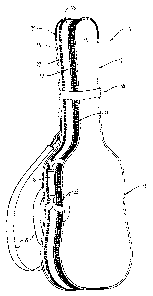Une partie des informations de ce site Web a été fournie par des sources externes. Le gouvernement du Canada n'assume aucune responsabilité concernant la précision, l'actualité ou la fiabilité des informations fournies par les sources externes. Les utilisateurs qui désirent employer cette information devraient consulter directement la source des informations. Le contenu fourni par les sources externes n'est pas assujetti aux exigences sur les langues officielles, la protection des renseignements personnels et l'accessibilité.
L'apparition de différences dans le texte et l'image des Revendications et de l'Abrégé dépend du moment auquel le document est publié. Les textes des Revendications et de l'Abrégé sont affichés :
| (12) Demande de brevet: | (11) CA 2598376 |
|---|---|
| (54) Titre français: | ETUI EXTENSIBLE D'INSTRUMENT A CORDES |
| (54) Titre anglais: | EXPANDABLE STRINGED INSTRUMENT CASE |
| Statut: | Réputée abandonnée et au-delà du délai pour le rétablissement - en attente de la réponse à l’avis de communication rejetée |
| (51) Classification internationale des brevets (CIB): |
|
|---|---|
| (72) Inventeurs : |
|
| (73) Titulaires : |
|
| (71) Demandeurs : |
|
| (74) Agent: | SMART & BIGGAR LP |
| (74) Co-agent: | |
| (45) Délivré: | |
| (22) Date de dépôt: | 2007-08-23 |
| (41) Mise à la disponibilité du public: | 2008-02-23 |
| Licence disponible: | S.O. |
| Cédé au domaine public: | S.O. |
| (25) Langue des documents déposés: | Anglais |
| Traité de coopération en matière de brevets (PCT): | Non |
|---|
| (30) Données de priorité de la demande: | ||||||
|---|---|---|---|---|---|---|
|
An instrument case including a bottom wall, a top wall, and a primary side
wall forming a first compartment. The primary side wall has a lower wall
portion
joined to the bottom wall and an upper wall portion joined to the top wall.
Together,
the upper and bottom walls have a substantially uniform width w to establish
for the
first compartment a first volume for accommodating an instrument having a
maximum width no greater than the uniform width w. A flexible auxiliary side
wall
is contractible within the primary side wall and joins the bottom wall and the
top
wall. The auxiliary side wall has a substantially uniform width W greater than
the
width w of the primary side wall and is expandable to establish a second
compartment with a second volume for accommodating an instrument having a
maximum width greater than the uniform width w.
Note : Les revendications sont présentées dans la langue officielle dans laquelle elles ont été soumises.
Note : Les descriptions sont présentées dans la langue officielle dans laquelle elles ont été soumises.

2024-08-01 : Dans le cadre de la transition vers les Brevets de nouvelle génération (BNG), la base de données sur les brevets canadiens (BDBC) contient désormais un Historique d'événement plus détaillé, qui reproduit le Journal des événements de notre nouvelle solution interne.
Veuillez noter que les événements débutant par « Inactive : » se réfèrent à des événements qui ne sont plus utilisés dans notre nouvelle solution interne.
Pour une meilleure compréhension de l'état de la demande ou brevet qui figure sur cette page, la rubrique Mise en garde , et les descriptions de Brevet , Historique d'événement , Taxes périodiques et Historique des paiements devraient être consultées.
| Description | Date |
|---|---|
| Inactive : CIB désactivée | 2021-11-13 |
| Inactive : CIB en 1re position | 2020-08-09 |
| Inactive : CIB attribuée | 2020-08-09 |
| Inactive : CIB expirée | 2020-01-01 |
| Le délai pour l'annulation est expiré | 2012-08-23 |
| Demande non rétablie avant l'échéance | 2012-08-23 |
| Réputée abandonnée - omission de répondre à un avis sur les taxes pour le maintien en état | 2011-08-23 |
| Demande publiée (accessible au public) | 2008-02-23 |
| Inactive : Page couverture publiée | 2008-02-22 |
| Inactive : CIB en 1re position | 2007-10-12 |
| Inactive : CIB attribuée | 2007-10-12 |
| Inactive : Certificat de dépôt - Sans RE (Anglais) | 2007-09-25 |
| Demande reçue - nationale ordinaire | 2007-09-21 |
| Date d'abandonnement | Raison | Date de rétablissement |
|---|---|---|
| 2011-08-23 |
Le dernier paiement a été reçu le 2010-08-04
Avis : Si le paiement en totalité n'a pas été reçu au plus tard à la date indiquée, une taxe supplémentaire peut être imposée, soit une des taxes suivantes :
Les taxes sur les brevets sont ajustées au 1er janvier de chaque année. Les montants ci-dessus sont les montants actuels s'ils sont reçus au plus tard le 31 décembre de l'année en cours.
Veuillez vous référer à la page web des
taxes sur les brevets
de l'OPIC pour voir tous les montants actuels des taxes.
| Type de taxes | Anniversaire | Échéance | Date payée |
|---|---|---|---|
| Taxe pour le dépôt - générale | 2007-08-23 | ||
| TM (demande, 2e anniv.) - générale | 02 | 2009-08-24 | 2009-08-24 |
| TM (demande, 3e anniv.) - générale | 03 | 2010-08-23 | 2010-08-04 |
Les titulaires actuels et antérieures au dossier sont affichés en ordre alphabétique.
| Titulaires actuels au dossier |
|---|
| FIRST ACT, INC. |
| Titulaires antérieures au dossier |
|---|
| CEDRIC LIAUTAUD |
| CRAIG SMALL |
| MARK S. IZEN |